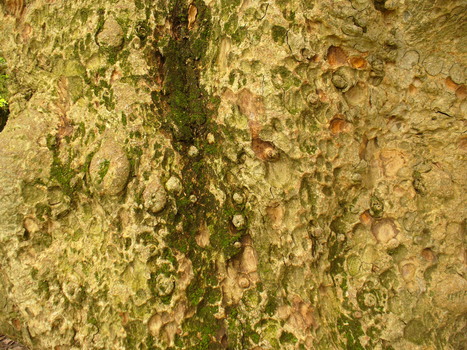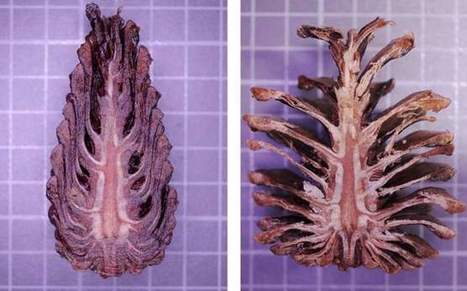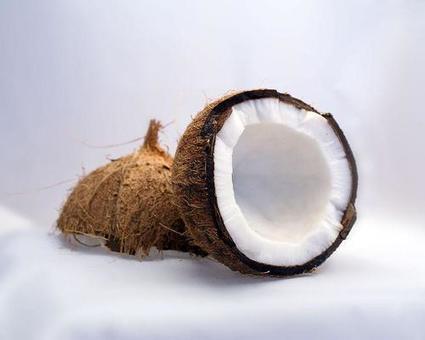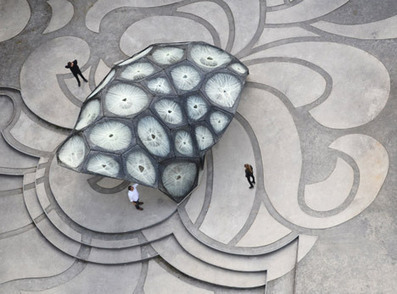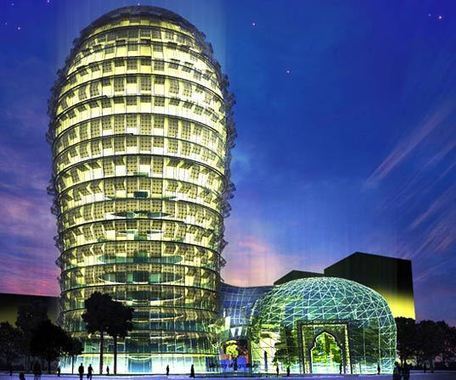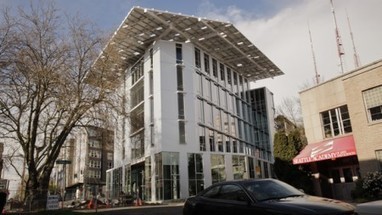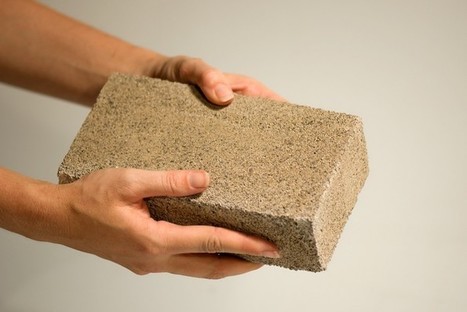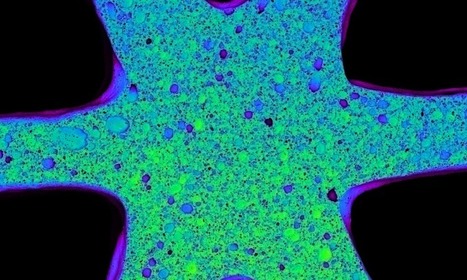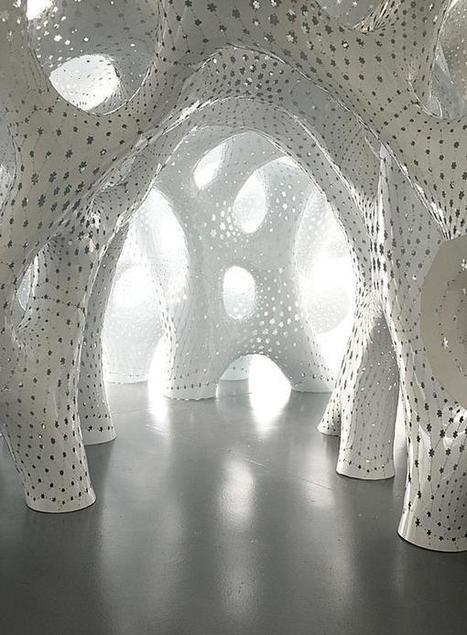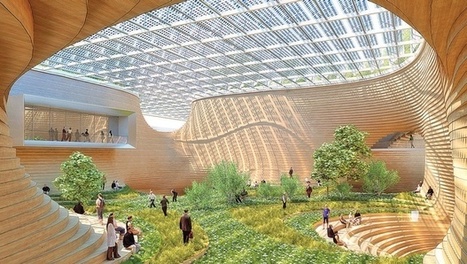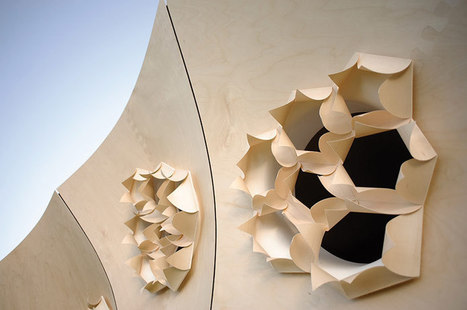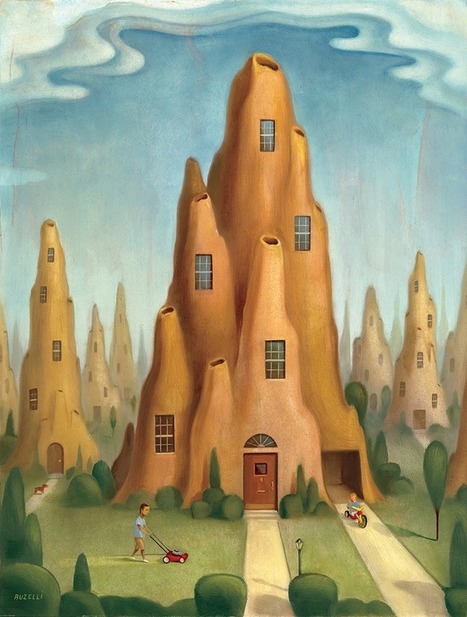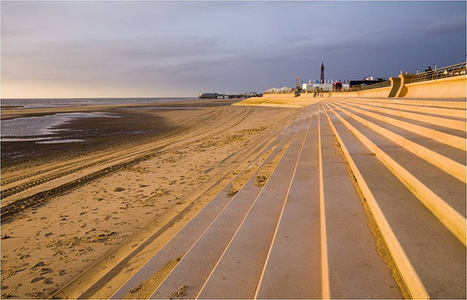 Your new post is loading...
 Your new post is loading...
"The overheating of buildings and their need for mechanical cooling is a growing issue as a result of climate change. The main aim of this paper is to examine the impact of surface texture on heat loss capabilities of concrete panels through evaporative cooling. [...] A systematic process was been undertaken to examine the impact of different variables on the cooling ability...[...] This study demonstrates the potential exploitation of morphological adaptation to buildings, that could contribute to them cooling passively and reduce the need for expensive and energy consuming mechanical systems."
Cones produced by such trees as pines, spruce, hemlock, and fir respond naturally to different degrees of humidity by opening and closing, without consuming any electrical energy in doing so. Designing window blinds based on their mechanical properties that could open and close in response to moisture — but use no energy in the process — could conserve a lot of energy.
"Coconut palms can grow as high as 30m, and when the ripe fruits fall to the ground their walls must protect them from splitting open. To protect the internal seed, coconuts have a structure of three layers which allow them to withstand heavy impacts. The university’s Plant Biomechanics Group believes this specialised structure could be applied in architecture, and has been working with civil engineers and material scientists to develop this idea as part of a programme called Biological Design and Integrative Structures. [...] The group found that the ladder-like design of vessels in the coconut’s inner endocarp layer “dissipates energy via crack deflection," meaning newly-developed cracks created by an impact don't run directly through the hard shell, but are diverted and stop before the crack separates the fruit. "
A concrete developed by Dutch scientists and embedded with limestone-producing bacteria is ready to hit the market
"Royal College of Art design student Chao Chen has developed a revolutionary new building material that responds to the presence of water. After observing the hydro-sensitive behavior of pine cones, which open and close depending upon their exposure to water, Chen has developed a wood laminate material that similarly bends and flexes in response to atmospheric humidity, soil moisture or rain. Applications for the technology include shelters that seal up when it rains and building cladding that opens to let in more light on a dull, drizzly day but closes to block out heat when the weather is hot and dry."
"When urban infrastructure meets nature’s designers, amazing things can happen. More and more, biomimicry is being thought of as a way to reconsider the ways we build and operate cities. Today, these lessons are being actively applied in the realm of urban infrastructure and design in an effort to make places that are more sustainable, more livable, more intuitively designed and, at their core, more natural."
"In recent years, architects, biologists, and engineers have been thinking about the possible connection the architectural field can have with living entities, such as insects or trees. Most of the time, architects design projects based on the imitation of natural forms. This imitation takes place in a field where there haven’t been previous studies about the organism being imitated, its basic organic functions, and its interaction with the environment. This concept is called biomorphism. When you add in concepts such as biomimicry and biomimetics as theoretical foundations, the design process is focused on the understanding of the functions of the project, how its functions and structure can be solved by studying a specific organism, and, in some supported research projects, how it can be built with parametric design."
A robotically woven carbon-fibre pavilion based on the lightweight shell encasing a beetle's wings and abdomen is revealed by the University of Stuttgart.
"Imagine a concert hall of coral rising like Atlantis from the sea. Or a data centre in the side of a mountain, complete with Bond villain subterranean lake. Exploration Architecture has produced designs for a restaurant on Old Street roundabout, and even started farming in the desert, but which is your favourite? The designs are all ‘biomimetic’ solutions; they all have mimicked nature to solve a human design problem. "
With balconies budding like leaves, no one could complain for lack of outdoor space in this building in France.
"HOK’s 2035 master plan for Bandar Seri Begawan in Brunei looks to the city’s original water-driven form for future inspiration. [...] The city rests at the intersection of three rivers, and is surrounded by the Borneo rainforest, but has suffered from a lack of cohesive direction."
"The Minister of Municipal Affairs & Agriculture (MMAA) in Qatar is getting a brand new office building that takes the form of a towering cactus. Designed by Bangkok-based Aesthetics Architects, the modern office and adjoining botanical dome take cues from cacti and the way that they successfully survive in hot, dry environments."
"It’s nearly 100 feet tall, fed by the sun and rain that fall on it, and is composed largely of wood. But it’s not a tree. It’s the world’s greenest office building. The Bullitt Center, finished in the summer of 2013 and located on the edge of Seattle’s downtown, is designed to mimic the Douglas fir forests that once stood on the site."
|
"[...] bioMason grows bricks and masonry without using any heat.
[...] It starts by packing sand into regular molds, which are then inoculated with bacteria. The bacteria wrap themselves around grains of sand. Each grain acts as a nucleus and calcium carbonate crystals form around it. The bricks are then fed nutrient-rich water via an irrigation system for the next couple of days, speeding up the growth of the crystals which then fill the gaps between grains of sand. After four days, the bricks are strong, durable and ready to be used on the construction yard, and the water is then reused for the next set."
"Nature does amazing things with limited design materials. Grass, for example, can support its own weight, resist strong wind loads, and recover after being compressed. The plant's hardiness comes from a combination of its hollow, tubular macrostructure and porous microstructure. These architectural features work together to give grass its robust mechanical properties. Inspired by natural cellular structures, researchers at the Harvard John A. Paulson School of Engineering and Applied Sciences (SEAS), the Wyss Institute for Biologically Inspired Engineering at Harvard University, and MIT have developed a new method to 3D print materials with independently tunable macro-and microscale porosity using a ceramic foam ink."
From creating breathable metals to copying how animals cool their homes, architects and designers are increasingly using the principles of biomimicry in their work. Christopher DeWolf takes a look at how the discipline is evolving.
"The Orchid, a source of life and symbol of sustainability and fecundity, is the inspiration for the shopping mall ‘Wooden Orchids’ designed by architect Vincent Callebaut. On the southern shore of the Yangtze river in China, Wooden Orchids is designed as an innovative solution to the main socio-economic problem – the rural exodus into super cities which causes undue stress on city resources. The project aims to create a new eco-responsible shopping and rich cultural experience, while maintaining it as a tourist destination that combines passive bioclimatic principles and renewable energy technology to assure 70 per cent energy saving. Based on biomimicry, the architecture of the shopping hub is directly inspired by the petals of an orchid flower and designed as repetition of a basic designed module. The site is divided into two lots, each in proportions of the golden section 1:1.618. The natural order of Fibonacci numbers, observed everywhere in nature, has been adopted to develop the hierarchy and flow of spaces and places, representing the right balance between solid and void, between shadow and light." ...
"During the last century and a half, humans have created cities that ignore natural cycles such as the weather and surrounding conditions, and have developed urban areas that have little to do with life in the natural world. The control of resources and mastery of energy sources has allowed us to become carelessly independent from our natural environment—which has led to a downward unsustainable path, currently incapable of supporting the massive population growth predicted for the world’s biggest cities. [...] Nature is holding sustainable solutions to numerous city design and development problems we are currently facing—we just have to look deeper to see where the solutions are already being applied in the natural world."
The Eiffel Tower weighs less than the air around it. It achieves this by exploiting the same structural ideas that make your bones so strong yet so light.
Our reliance on air conditioning, however magical an innovation, has become a serious environmental burden. Which is why researchers in Barcelona designed a material they say can naturally cool rooms by about 5 degrees Celsius, using a moisture-absorbing polymer that "sweats" much like our own body.
The Biotic-Tech Skyscraper City uses biomimicry and is inspired by squid, using transparency, flexibility, movement and protective pigmentation.
"Research on the spruce cone has led to a complex skin system that responds to localized climatic environments through the natural, mechanical properties of wood and humidity."
"In 1991, the multinational Old Mutual investment group approached the Zimbabwean architect Mick Pearce with an audacious assignment. The group wished to construct a retail and office complex called the Eastgate Centre in Zimbabwe’s capital city of Harare that, at 55,000 square meters, would be the country’s largest commercial building. What Old Mutual didn’t wish to do was pay the high cost of air-conditioning such a massive space. Could Pearce, working with the Arup construction firm, devise a design that relied solely on passive, natural climate control? Pondering the problem, Pearce found inspiration in the termite mounds that dotted the savannas across his country. "
"The resort town of Blackpool on the UK’s northeast coast is a classic example of what can go wrong when you work against natural coastline dynamics. It was built on a sand dune, which, as the town expanded, the Victorians replaced with a monumental 10-meter/30-foot-high seawall. This severed the town from its main asset, its beach, and as competition grew from continental European destinations, Blackpool fell into economic decline. To make matters worse, by the early 2000s the seawall was failing to hold back increasingly stormy winter seas, which began to flood the town. The solution has been to learn from the dunes. The high wall has been replaced with a gently sloping set of steps stretching the length of the town, mimicking the incline of sand dunes to dissipate wave energy.."
"Technically speaking, the smart facade-or building envelope that adapts to environmental conditions-dates back to the first window. But the contemporary idea of the smart facade has only been around for a few short decades, helped along by recent advances in chemical and material science. And over the past three years, we've seen the category boom. Below, check out some of the most interesting building facades to come across the screen in recent years: From a thermal metal screen that curls up when it's hot, to a titanium dioxide-covered wall that scrubs the air of pollutants."
|







 Your new post is loading...
Your new post is loading...
